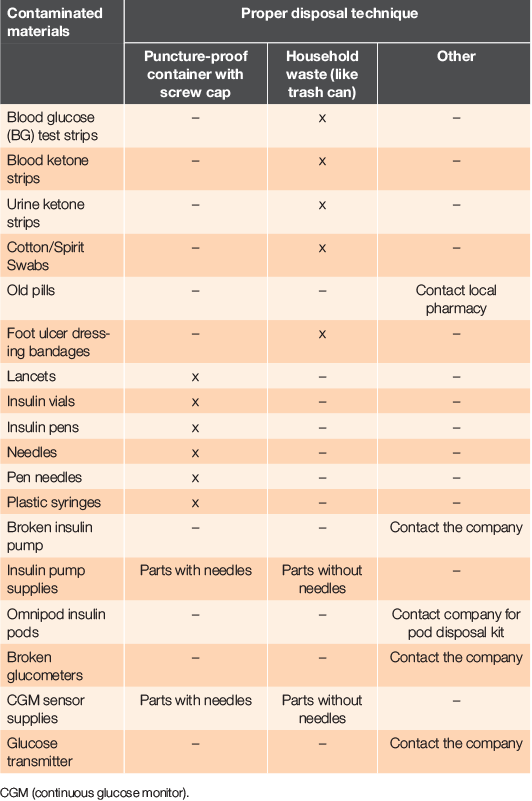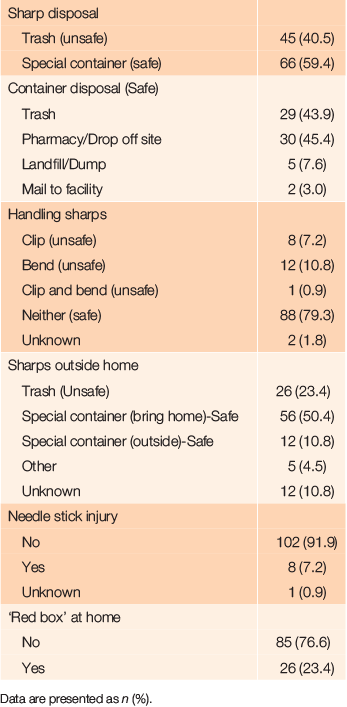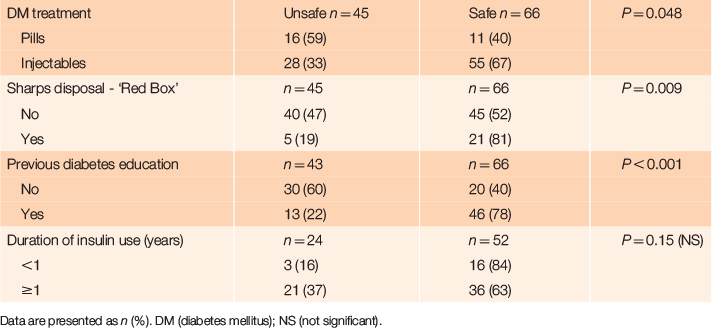Green diabetes mellitus: a pilot project
Sadia Ashraf 1 3 , Cheryl Roe 2 , Nidhi Bansal 11 Department of Medicine, Division of Endocrinology, Diabetes and Metabolism, SUNY Upstate Medical University, 3229 East Genesee Street, Syracuse, NY 13214, USA
2 Institute for Human Performance (IHP), 505 Irving Ave., Syracuse, NY 13210, USA
3 Corresponding author. Email: drsadia2013@gmail.com
Journal of Primary Health Care 11(4) 367-372 https://doi.org/10.1071/HC19012
Published: 6 December 2019
Journal Compilation © Royal New Zealand College of General Practitioners 2019 This is an open access article licensed under a Creative Commons Attribution-NonCommercial-NoDerivatives 4.0 International License
Abstract
INTRODUCTION: Most of approximately 422 million people globally have diabetes mellitus use sharps for glucose monitoring. Many adults with diabetes are unaware of safe disposal methods, posing a risk of injury or potential infection to others.
AIM: To determine how adults with diabetes dispose of diabetes care-related waste and to assess changes in their disposal habits after receiving brief targeted education during medical visits.
METHODS: Ambulatory adults with diabetes (aged ≥18 years) were enrolled during their medical visit. After completing an initial questionnaire, a handout on safe disposal practices was discussed with them, which was followed by a second questionnaire 3 months later.
RESULTS: There were 111 participants at baseline (mean age 55 years, 50.4% had diabetes for >10 years, 52% female, 74.7% insulin users, 59.4% had home sharps containers, 53.1% had previous diabetes education). Of these, 40.5% reported disposing of sharps in their household trash. Insulin use, previous diabetes education or having a ‘Red Sharps’ container at home were each significantly associated with safe disposal (all P < 0.05). Of the 96 (86.5%) participants who completed the second questionnaire, unsafe disposal of sharps fell from 39.6% to 10.4% (P < 0.001). Preferred method of container disposal was the use of drop-off sites (pharmacies, doctors’ offices and hospitals). Outside their homes, 18.8% of completers had used regular trash for sharps disposal. Post education, this fell to 8.7% (P = 0.065). Post education, reuse of sharps decreased from 38.3% to 14.9% (P < 0.001) and improper handling of sharps (eg bending or cutting) fell from 18.8% to 9.4% (P = 0.004).
CONCLUSIONS: Safe sharps disposal can be improved by providing a simple handout with a brief discussion at the time of medical visits. Disposal methods that are easy, convenient and free-of-charge are needed to further increase safety.
KEYwords: Sharps; diabetes mellitus; healthcare-related waste
Introduction
Approximately 422 million people globally (including 30.3 million people in the USA (9.3% of population)) have diabetes mellitus (DM), many of whom use ‘sharps’ (lancets for self-monitoring of blood glucose, needles, injectable medications, insulin pumps and continuous glucose monitors).1–3 Approximately 3 billion needles and syringes are used each year outside of health-care facilities in the USA.1,4 As the number of people living with diabetes grows, diabetes care-related home waste required for self-management also increases. This waste places a burden on the environment. Many adults with DM are unaware of safe disposal methods available to them and simply throw medical waste in with household trash. This poses a risk of injury or potential infection to others in the community, such as sanitation and sewage treatment workers, janitors, housekeepers and children.5 Although many improvements have been made to waste and sharps disposal practices in health-care settings, disposal practices of people with DM living at home have been poorly studied. Barriers to safe disposal include lack of education of where and how to dispose of diabetes care-related waste and lack of easy access to disposal sites.
The aim of this study was to determine how adults with diabetes followed at our centre dispose of diabetes care-related waste and to assess changes in diabetes waste disposal habits after receiving brief targeted education during their medical visits.
Methods
This prospective study was conducted at the Joslin Diabetes Center at SUNY Upstate Medical University, Syracuse, New York from August 2016 to July 2017.
Patients could be included in the study if they had a diagnosis of DM and were aged ≥18 years. Excluded were adults who were not responsible for, or capable of, disposing of their diabetes-related waste (these tasks were performed by others) or who could not provide informed consent. The study questionnaire was adapted from earlier research conducted in the USA, Pakistan and the Philippines.6–8 Participants (n = 111) were recruited at our centre for diabetes treatment when they came for their routine diabetes medical visit. They were seen by two investigators and informed consent was obtained.
Methods for patients’ disposal of diabetes care-related waste were self-reported in an initial questionnaire. Then participants were given a simple three-page handout on safe disposal practices, which was discussed with them for up to 5 minutes. Key elements of the handout are shown in Table 1.

|
Three months after the initial education, participants were asked to complete a post-education questionnaire to assess potential changes in their disposal habits and to obtain feedback on their preference of disposal methods. The post-education questionnaire was completed either at a follow-up visit or by phone.
The primary endpoint was improvement in awareness and implementing of safe disposal techniques. The secondary goal was to better understand participants’ preferred method for safe sharps disposal. Data from the pre- and post-education surveys were initially entered into Microsoft Excel spreadsheets (Microsoft Corporation, Redmond, WA, USA). After all responses were collected, all data were imported into IBM SPSS Statistics 22 (SPSS Inc., Chicago, IL, USA) for analysis. Descriptive statistics were produced for each survey question, examining the pre- and post-education responses separately. Frequencies provided overall counts and percentages of answer choices for each question, by time point. Cross tabulations were generated to examine possible differences in response choices depending on demographic characteristics, again for each of the two time points separately. To assess the effectiveness of the training, the dataset was trimmed to include only participants with data for both the pre- and the post-education questionnaires. For each question, McNemar’s Test for paired proportions was used to test for significant changes in the distribution of responses after administration of the safe disposal practices education. The Institutional Review Board (IRB) for the protection of human subjects at SUNY Upstate Medical University approved the study.
Results
Participants’ (n = 111) mean age was 55 years (standard deviation (s.d.) 15.3 years); 54% were female; 70.3% were Caucasian, 15.3% were African American and 5.4% were Hispanic. Most (83.8%) had type 2 DM and 50.4% had DM for a duration of >10 years (Table 2). Seventy-four percent of participants were either using insulin alone or in combination with oral medication or other non-insulin injectable. Only 26.8% had been taking insulin for >10 years. With respect to diabetes education, 53.1% of participants had received formal DM education, mostly from the nurses in the physician’s office. Out of the 59.4% of participants who were using home sharps containers, 43.9% and 45.4% (respectively) disposed of their container in the household trash or by dropping it off to pharmacies (Table 3). Approximately 79% were handling the sharps appropriately (not clipping or bending). When outside their home, 23.4% of participants disposed of sharps in the trash: the rest either brought sharps home in their sharps container (50.5%), used the available sharps container at the outside facility (10.8%) or did not use sharps at all (15.3%). Fifty-nine percent of participants did not reuse their sharps (including lancets and needles). Most participants (91.9%) denied any needle stick injury. Only 23.4% had a ‘Red Box’ sharps disposal container at home.

|

|
Insulin use (P = 0.048), previous diabetes education (P < 0.00) and having a ‘Red Box’ at home (P = 0.009) were associated with safe disposal (Table 4). Of participants who used insulin or who had previous diabetes education, 67% and 77.9% respectively disposed of sharps appropriately at baseline. Gender, race, insurance status, education level, type and duration of DM and duration of insulin use were not significantly associated with safe sharps disposal.

|
At the 3-month follow up, 86.5% of participants (n = 96) completed the questionnaire. Unsafe disposal of sharps fell from 39.6% to 10.4% (P < 0.001). The preferred method of sharps disposal was the use of drop-off sites (pharmacies, doctor’s office or hospitals). Outside their home, 18.8% of completers of the both questionnaire had used regular trash for sharps disposal. Post education, this fell to 8.7% (P = 0.065). Post education, reuse of sharps decreased from 38.3% to 14.9% (P < 0.001) and improper handling of sharps (eg bending or clipping) fell from 18.8% to 9.4% (P = 0.004). Most participants did not complete the question regarding diabetes care-related non-sharp waste, so we could not assess the effect of education on non-sharp waste disposal.
Discussion
In our study, 40% of participants were inappropriately disposing of sharps in their trash. This compares to 50% in a 2010 study in Virginia and 82% in a study conducted in the Philippines in 2014.6,8 In our study, almost 45% of participants had not received education that included the proper disposal of sharps. Safe methods of sharps disposal in the community include drop boxes and supervised collection sites such as hospitals, health clinics, pharmacies, police and fire stations, and medical waste facilities. Other options include mail back and syringe exchange programmes, use of hazardous waste collection sites, special waste pickup services and use of at-home needle destruction devices.9
Not all services are available in every USA state, and within states, resources are not uniformly available; for example, some towns in New York state allow residents to dispose of proper sharps containers alongside their trash can for pickup but other towns do not.10,11 Also, clipping as a method of disposal is not allowed in New York State, but it is allowed in other states such as Maine. Our participants preferred to dispose of sharps at physicians’ offices, hospitals and pharmacies. These sites are convenient as patients visit these locations regularly for health issues. In New York, increasing the number of days and hours at hospitals and nursing homes for community sharps collections from 2001 to 2004 was associated with greater public use of those sites (P < 0.001).11 Outside patients’ homes, we also recommend that public restrooms should have sharps disposal containers. As we have awareness days for various medical and non-medical issues (and recently in March 2018, the first global recycling day was initiated), we also propose an awareness day for proper sharps disposal.
We found that discussion with patients during their medical visits about sharps disposal improved proper disposal over a 3-month period. Whether this improvement persists over a longer duration will require further study.
Strengths of our study include its prospective design and data collection conducted pre- and post-education; most previous studies have been cross-sectional surveys. Also, the education method used in this study was consistent and provided by two investigators. Limitations of our study include its single site, small sample size, short duration of follow up and one-time teaching.
Conclusions
For adults with DM, diabetes-related waste disposal can be improved by providing a simple handout with a brief discussion at the time of medical visits. Disposal methods that are easy, convenient and free-of-charge are needed to further increase safety.
Funding
This research did not receive any specific funding.
Competing interests
The authors declare that they have no competing interests.
Acknowledgements
Thanks to our diabetes educators including Kristi Shaver RN, CDE, Kathleen Obrien RN, CDE and Marie Morley RN, CDE for their assistance in revising patient study questionnaire and patient education handout.
References
[1] Centers for Disease Control and Prevention. Updated 2018. [cited 2018 May 7]. Available from: https://www.cdc.gov/diabetes/new/index.html[2] Diabetes. WHO.int; 2018 [cited 2019 July 19]. Available from: https://www.cdc.gov/diabetes/index.html?CDC_AA_refVal=https%3A%2F%2Fwww.cdc.gov%2Fdiabetes%2Findex.htm
[3] King H, Aubert R, Herman W. Global burden of diabetes 1995–2025: prevalence, numerical estimates, and projections. Diabetes Care. 1998; 21 1414–31.
| Global burden of diabetes 1995–2025: prevalence, numerical estimates, and projections.Crossref | GoogleScholarGoogle Scholar | 9727886PubMed |
[4] SafeNeedleDisposal.org. Updated 2018. [cited 2018 May 7]. Available from: https://safeneedledisposal.org/
[5] Community options for safe needle disposal. Updated October 2004. [cited 2018 May 18]. Available from: https://www.epa.gov/rcra/community-options-safe-needle-disposal
[6] Musselman KT, Sicat Bl, Thomas MH, Harpe SE. Patients’ knowledge of and practices relating to the disposal of used insulin needles. Innov Pharm. 2010; 1 1–10.
| Patients’ knowledge of and practices relating to the disposal of used insulin needles.Crossref | GoogleScholarGoogle Scholar |
[7] Ishtiaq O, Qadri AM, Mehar S, et al. Disposal of syringes, needles, and lancets used by diabetic patients in Pakistan. J Infect Public Health. 2012; 5 182–8.
| Disposal of syringes, needles, and lancets used by diabetic patients in Pakistan.Crossref | GoogleScholarGoogle Scholar | 22541266PubMed |
[8] Quiwa L, Jimeno C. Knowledge, attitudes and practices on the disposal of sharps in patients of the UP-Philippine general hospital diabetes clinic. J ASEAN Fed Endocrine Soc. 2014; 29 141–50.
[9] U.S. Food and Drug Administration. Free printable visual learning guides for safe sharps disposal. Updated 24/1/2018. [cited 2018 June 4]. Available from: https://www.fda.gov/MedicalDevices/ProductsandMedicalProcedures/HomeHealthandConsumer/ConsumerProducts/Sharps/ucm381982.htm
[10] Turnberg WL, Jones TS. Community syringe collection and disposal policies in 16 states. J Am Pharm Assoc. 2002; 42 S99–104.
| Community syringe collection and disposal policies in 16 states.Crossref | GoogleScholarGoogle Scholar |
[11] Klein SJ, Candelas AR, Cooper JG, et al. Increasing safe syringe collection sites in New York state. Public Health Rep. 2008; 123 433–40.
| Increasing safe syringe collection sites in New York state.Crossref | GoogleScholarGoogle Scholar | 18763405PubMed |


